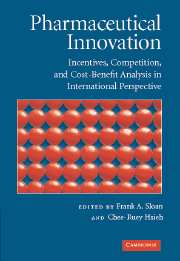 Pharmaceutical Innovation
Pharmaceutical Innovation Published online by Cambridge University Press: 18 December 2009
Introduction
This final chapter summarizes key findings and conclusions of the previous chapters and explores their policy implications. More specifically, we discuss eight policy issues that arise as governments seek to promote pharmaceutical innovation in their countries as well as to cope with the consequences of such innovation on public and private budgets, distinguishing between new innovations that are worth the extra cost from those that are not. The issues, which have implications for public decision making ranging from industrial to health policy, are (1) whether or not a country without a well-developed pharmaceutical sector can successfully promote developing such a sector with an industrial policy, (2) strategies for promoting pharmaceutical innovation, (3) incentives for development and production of vaccines, (4) public provision of information on pharmaceutical cost and effectiveness, (5) policies to promote competition in markets for pharmaceutical products, (6) differentials in prices of pharmaceutical products among countries, (7) health benefits of pharmaceuticals, and (8) how governments cope with pharmaceutical innovation.
Is an Industrial Policy Aimed at Promoting Development of a Pharmaceutical Industry Likely to Succeed?
Government policy makers wear two hats vis-à-vis the pharmaceutical sector: (1) seeking to promote economic growth by increasing national employment and income, key objectives of industrial policy, and (2) promoting personal health and life expectancy and averting the spread of pandemics, key objectives of health policy, the latter being more likely to succeed as a consequence of the widespread availability and use of innovative pharmaceutical products (Sloan and Hsieh, Chapter 1).
To save this book to your Kindle, first ensure [email protected] is added to your Approved Personal Document E-mail List under your Personal Document Settings on the Manage Your Content and Devices page of your Amazon account. Then enter the ‘name’ part of your Kindle email address below. Find out more about saving to your Kindle.
Note you can select to save to either the @free.kindle.com or @kindle.com variations. ‘@free.kindle.com’ emails are free but can only be saved to your device when it is connected to wi-fi. ‘@kindle.com’ emails can be delivered even when you are not connected to wi-fi, but note that service fees apply.
Find out more about the Kindle Personal Document Service.
To save content items to your account, please confirm that you agree to abide by our usage policies. If this is the first time you use this feature, you will be asked to authorise Cambridge Core to connect with your account. Find out more about saving content to Dropbox.
To save content items to your account, please confirm that you agree to abide by our usage policies. If this is the first time you use this feature, you will be asked to authorise Cambridge Core to connect with your account. Find out more about saving content to Google Drive.